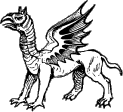Griffin
Griffin
Griffin, or Gryphon, (fr. griffon): the Griffin is the most frequently represented of the imaginary animals introduced into coats of arms. Although variously drawn, the great principle is that it is a compound of the Lion and the Eagle. The lower part of its body, with the tail and the hind-legs, belong to the lion; the head and the fore-part, with the legs and talons, to those of the eagle, but the head retains the ears of the lion. It has large wings, which also closely resemble those of the eagle. Its ordinary positions are rampant segreant(generally blazoned segreant only), and passant segreant.


It may be represented as without wings, and then with rays or spikes of gold proceeding from several parts of its body. Sometimes it has two long straight horns. The term Alce is given, as if used by writers for a kind of griffin, but no example can be quoted.
Azure, a griffin segreant or--READ, Herts.
Gules, a griffin segreant, or--RIVERS, Earl of Devon.
The representation on the shield of READ is, according to the mode of drawing the griffin, sometimes seen, but the example taken from the supporters to the arms of Alexander ANNAND of Elton is the more usual way of drawing the animal.
Griffins' heads are also represented in some coats. They are readily distinguishable from the eagles' heads by the presence of the ears.
Argent, a griffin segreant gules, beaked and legged or--CATERALL and GRIMSHAW, Lancashire.
Sire Geffrey fitz WYTHE, de azure a iij grifons de or--Roll, temp. ED. II.
Sire Robert de BRENTE, de goules a un griffoun de argent--Ibid.
Sire Rauf de CORT' de goules a un griffoun de or--Ibid.
Monsire John GRIFFEN, sable a une griffin argent beke et peds or--Roll, temp. ED. III.
Argent, a griffin segreant, coward sable--GODFREY.
Azure, a griffin segreant volant or, supporting an oak-branch vert, acorned of the second--REDE.
Vert, a griffin segreant or, beaked, legged, and ducally gorged argent--COLLINS, Kent.
Or, a gryphon segreant sable, in chief two mullets of six points gules, pierced of the field--Nelson Smith MORGAN, Sussex.
Or, a griffin segreant sans wings sable, fire issuing from the mouth and ears proper; on a chief argent, three quatrefoils vert--SAMLER.
Per chevron or and ermine, in chief two griffin's heads erased proper--NEED, Nottingham.
Argent, three griffin's heads erased sable, beaked gules--TRENTHAM, Stafford.
Sable, a chevron or between three griffin's heads erased argent--Robert SKINNER, Bp. of Bristol, 1637; afterwards of Oxford, 1641-63.
The Dragon(fr. dragon), the next in importance to the griffin amongst the fictitious animals, seems perhaps to have had its origin in the stories brought by travellers who, on their way to the Holy Land, may have seen the crocodiles on the banks of the Nile, and exaggerated or idealized the form; and probably the word, in some of the instances in which it is used in the Bible, means the crocodile.
Represented usually like the griffin, that is, rampant, its head is that of a serpent, of which an essential addition in the forked tongue. It has also, like the griffin, ears. The body, as to its proportions, is that of a lion, but it is represented scaled, and the large wings, instead of being those of an eagle, are webbed and pointed, and resemble rather those of the bat. The legs are also scaled, and the feet are represented usually with webbed talons, instead of those of the eagle; a spur, however, is often added. The tail, instead of ending like that of a lion, is a tuft, is always represented as barbed in English arms, but in French arms it is sometimes represented as with a fish-tail, and twisted. The dragon may be also represented 'sans' wings.
Dragon's heads frequently occur as charges: the presence of the ears and of the barbed tongue distinguishes them from the heads of eagles or serpents.



Argent, a dragon rampant sable--DAUNEY.
Argent, a dragon volant in bend sable--RAYNON, Kent.
Or, a dragon segreant vert, on a chief gules three spear-heads argent--SOUTHLAND, Kent.
Vert, a dragon sejant with wings expanded between three escallops or--CARMALT, Cumberland.
Or, a chevron between three dragons sable--FOLBORNE.
Argent, a chevron gules between three demi-dragons couped, erect, vert--HEYGEYS.
Argent, three dragon's heads erect and erased azure without ears--HORSKE.
Argent, three dragon's heads erased, fire issuing from their mouths proper--HOLSALL,
The Dragon, like the Griffin, if often used as a crest, or as one of the supporters. The illustration here given is from one of the supporters to the arms of William HUGHES, of Gwerclas.
A sea-Dragon appears on the crest of Sir Jacob Gerrard, Bart. 1662.
The Opinicus is allied more nearly to the dragon in the forepart and in the wings; but it has a beaked head and ears, something between the dragon and the griffin. The hind part and the four legs are probably intended to represent those of a lion, but the tail is short, and is said to be that of the camel.
Two opinici vert, beaked sable, wings gules, are Supporters to the Insignia of the PLASTERERS' Company.
An opinicus, with wings endorsed or, is the Crest of the Company of BARBER SURGEONS.
Lion-Dragon: the foremost part of a lion conjoined to the hinder part of a dragon.
Rouge Dragon: a favourite badge of King Henry VII. and assumed as the dexter supporter of his arms. It was also the title of a pursuivant established by that monarch. See Herald.
See also Sea-Dragon.
Please Help!
DrawShield is a Free service supported by its users.

If you can, please help cover the cost of the server, or just buy the team a coffee to say thanks!
 Buy me a coffee
Buy me a coffee


